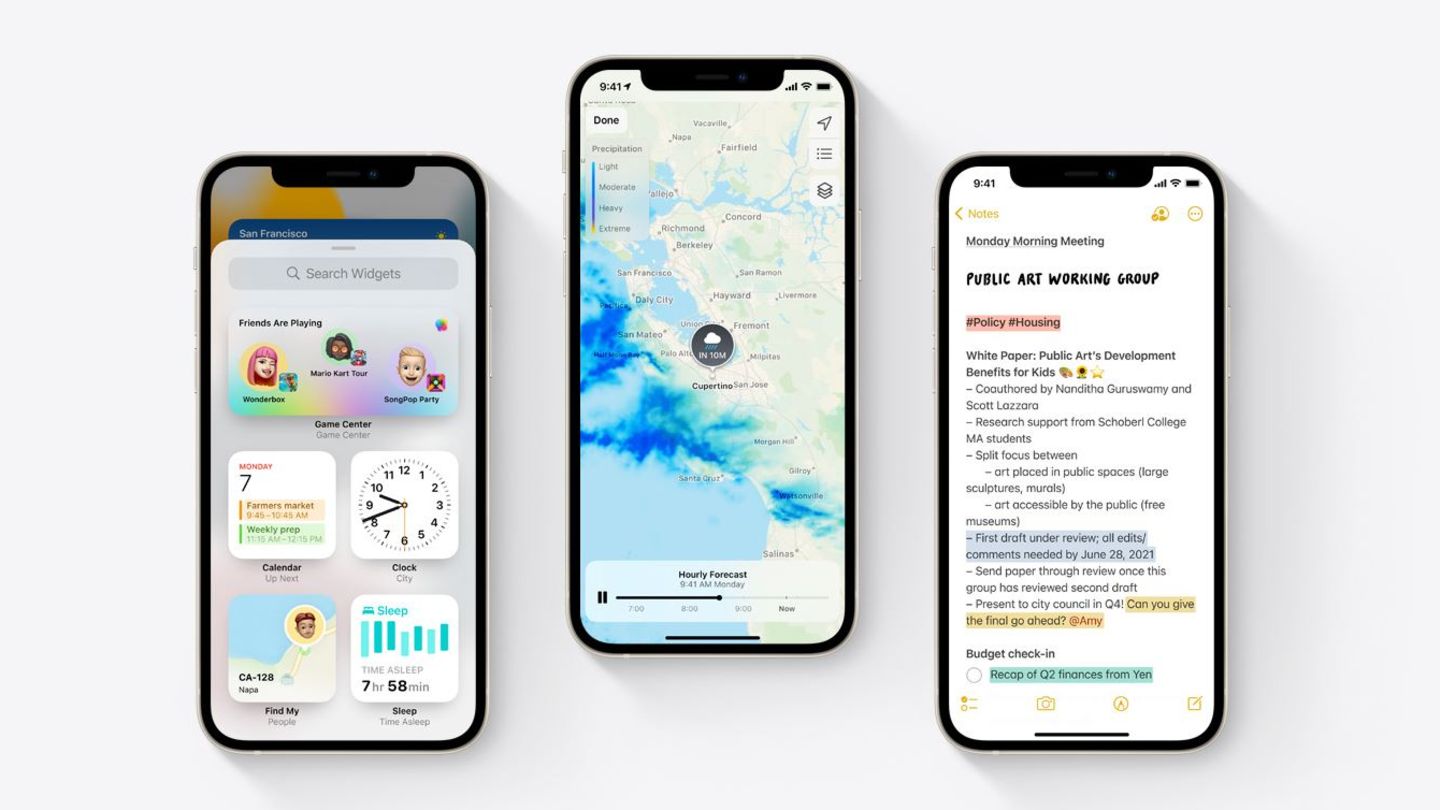The time has come: iOS 15 and iPadOS 15 will be available for download tonight – and bring tons of new functions to Apple’s mobile devices. We introduce the best.
Almost three months after the first presentation in June, Apple is releasing iOS 15 and iPadOS 15, its new operating systems for iPad and iPhone, on September 20. And as usual, a lot has happened. We present the most important innovations. And explain why the iPad benefits significantly more.
The most important changes, however, affect both systems – albeit to different degrees. While the iPhone and iPad got the same system and largely the same new functions for years, Apple separated the two systems two years ago. Some functions are exclusive to one of the new systems. However, this does not mean that they are completely decoupled: Most of the new features are available for both.
iOS 15 and iPadOS 15: This is new
One of the most important innovations: With the focus function, Apple is redesigning how notifications are received by the user. Instead of only limiting the number of notifications when sleeping or driving, you can now create your own scenarios and decide what comes through. You may not want to see the boss’s email in the after-work mode, on the other hand, the private Whatsapp group is of course annoying during working hours. In addition to suggestions such as rest phases or work mode, users can also define their own focus times in the settings and create a sport mode, for example.
Focus modes can be switched on automatically, for example according to the time, or you can activate them yourself. Switching off is similar. If you fumble with the iPhone again before the end of night mode, it asks, for example, whether you are awake and can switch off the notifications again.
The focus mode also has an impact on the notification center: notifications received and blocked during focus phases no longer appear individually in the headquarters, but are shown as a single group notification. Only when you tap on it can the individual notifications be seen. This separation between wanted and unwanted messages is a blessing for everyone who uses the smartphone both professionally and privately.
Safari: Everything new – if you want
Apple has also heavily rebuilt the Safari browser. On the iPhone, the new interface is a bit irritating at first, the address bar is suddenly at the bottom instead of at the top. However, once you get used to the new control, it works great. In addition to the address bar, which is now more accessible, especially on large iPhones, Apple has finally worked to end the tab chaos. If you now tap on the tab symbol, the new view appears, in which you can no longer see one, but two rows of tabs. This ensures a better overview, especially on the iPhone.
The option to assign tabs to a group is also new. To do this, tap on the display in which the currently open number of tabs is shown. There you can create tab groups or switch back and forth between them. If you instead tap on one of the open tabs and hold it down, you get the option to assign it to a tab group. Long pressed links can be assigned to a tab group.
The newly placed address bar also helps to simplify the control: if you swipe over the address bar, you switch to the previous or the next tab.You know it in a similar way from switching to the app using the menu bar at the bottom. If you don’t want to get used to the bar below, you can switch it off: Tap on the two “Aa” in the address bar and select the position of the tab bar.
Revised standard apps
Apple has also done a lot with its other included apps. The map app and the weather have been visually revised, both now offer more information. Unfortunately, not all of them come to Germany straight away: Many of the map improvements, such as a 3D view of cities, are only to be activated for the USA at first and then slowly distributed across the rest of the globe.
The revised Facetime is available everywhere. The control bar has now become smaller, it no longer takes up the entire screen. With new features, Apple’s video telephony pioneer should also adapt to the new requirements of home office and co. In this way, non-Apple users can finally be invited to face-time conversations with special links, and the background can be blurred. The microphone should learn to reproduce background noises more quietly. Too bad: The function called Shareplay, with which you can enjoy films or series together during a Facetime conversation, was highlighted during the presentation, but has now been postponed to a later date.
(Even) more privacy
In recent years, Apple has established the protection of privacy as an increasingly important feature of its ecosystem, and iOS 15 and iPadOS 15 also bring some exciting innovations here. Unfortunately not for every Apple user: The two most important new features – hiding the email address and the so-called private relay – are behind a payment barrier. They are only available to subscribers to the paid subscription service iCloud +, which many users book anyway because of the extended storage.
Both features ensure privacy, albeit in very different ways. The spam protection allows you to register for newsletters or websites with an e-mail address without giving your actual e-mail address to the services. Instead, iCloud + offers a camouflage address and forwards the mails. If too much spam arrives at one of the addresses, you simply switch it off – and you have peace of mind.
Data is also protected with the private relay: because information such as the approximate location can be read out via the IP address, switching on the function hides it from the websites visited. For example, traceability is becoming more difficult for advertisers. The highlight: Because Apple encrypts the address when it is passed on, the company itself does not know who is currently accessing which pages.
Unfortunately, there are a few minor drawbacks. Unlike with VPN services, you cannot select an IP from another country, for example to activate more offers on Netflix. In addition, some routers such as Google Wifi do not support the private relay correctly; the device then activates it in these networks. And: In some countries such as China or Egypt, the feature is not even offered. So it is not suitable for circumventing state censorship.
More innovations on the iPad
On the iPad, the new system is somewhat more extensive when it comes to innovations. But this is primarily due to the fact that Apple features such as the revised homescreen with widgets and the option to outsource apps to the so-called app library – they were already introduced on the iPhone with iOS 14.
Two exclusive innovations are intended to make the iPad more usable as a productive machine. On the one hand, there is the new multitasking feature. With a mini menu displayed at the top, the iPad can be quickly switched between the usual full-screen mode and a screen shared with several apps. In addition, as with the desktop, several windows of an app can now be opened so that you can switch between them. The note app can now be opened from all apps to capture quick thoughts.
Another important innovation is taking place in the background: Apps can now request more RAM. This should especially please users of the current iPad Pro with Apple’s M1 chip. Although this brings up to 16 GB of RAM, it has not been allowed to use any app to the full so far. Now Photoshop and Co. can call up significantly more.
iOS 15 and iPadOS 15 will be released on September 20, 2021 from around 7 p.m. German time.
David William is a talented author who has made a name for himself in the world of writing. He is a professional author who writes on a wide range of topics, from general interest to opinion news. David is currently working as a writer at 24 hours worlds where he brings his unique perspective and in-depth research to his articles, making them both informative and engaging.




